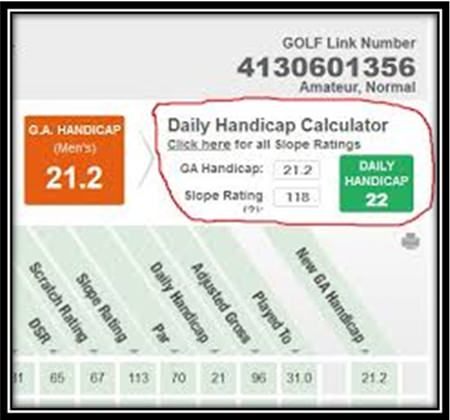In May of last year, this column attempted to answer why Aussie golf visitors occupied podium positions disproportionate to their playing numbers. The experiment Golf Australia (GA) had with the USGA Handicap System provided the answer. The article finished by saying that the advantage then enjoyed by many Aussie golfers would, due to the changes GA was introducing to its handicapping system, end over time.
The last of many planned handicap changes brought in by GA was introduced early this year. It involves the introduction of two handicaps – a base index handicap known as the GA Handicap, and a Daily Handicap. Knowing the difference between the two is important, especially if the group you play with entertains Aussie visitors – which most do.
 GOLF Link’s opening page – the key to GA’s handicap programme.
GOLF Link’s opening page – the key to GA’s handicap programme.
Last year’s article (www. golfnutter.wordpress.com/category/handicap-flaws/) gave a detailed account of the reasons Golf Australia decided to cease their three-year experiment with the USGA Handicap System. Their decision to revert back to a system that relies on measuring course difficulty on a daily basis – a basic tenet of British & Irish and European Handicapping Systems – was driven by fundamental differences in golfing culture.
Australian golfing culture centres on “the weekly comp.” This could be the Saturday Stableford or the mid-week par competition, it matters not. What does matter is that only scores from recognised competitions may be submitted for handicapping. These competitions are designed for individuals to compete against their fellow club members on the assumption that competent handicapping, within reason, promotes an even playing field. This is a golfing culture not far removed from our own, here in Pattaya, but that is another story.
The USGA Handicapping System, according to recent advice given to Golf Australia, was designed primarily for the dominant form of the game as played in the US; this being four-ball better-ball match. The 4BBBM format involving just two teams of two players, pitting their team’s better ball against the other teams better ball, is a long way removed from an individual competing in a field of 20 plus.
This difference in golfing culture has many implications when choosing an equitable handicapping system. Other differences between USGA and Golf Australia that may not be apparent include:
* Golf Australia’s insistence that a daily course rating be the basis of assessing individual performance against handicap.
* GA’s requirement that verified scores from recognised competitions only be accepted for handicapping.
* GA’s assertion that a player’s handicap should be reflective of their better performances. It should not increase substantially due to a temporary loss of form. For this reason, the volatility of the current USGA Handicap calculation, used to update handicaps, was amended from settings of 10 of 20 x 0.96 to 8 of 20 x 0.93. This will reduce the ability of handicaps to move as rapidly as they have in recent times.
* Also limiting the excessive movement of handicaps will be the Anchoring Rule; which will prevent movement of handicaps by more than four strokes in a 12-month period.
These and other amendments were intended to address what Golf Australia saw as fundamental flaws in the USGA Handicapping System, at least as far as it applied to golf in Australia. But what about portability of handicap; the main reason why Golf Australia converted to the USGA Handicap System in the first place?
From March 2013 Australian handicapping changed to what they refer to as a DSR and Slope dependant scheme, to be known as the GA Handicapping System. DSR stands for Daily Scratch Rating. Sound familiar? It will to those who know the CONGU, European or previous Australian Handicapping Systems.
This time, however, Golf Australia has designed their DSR so as to include an allowance for Slope, rather similar to that used by the European Golf Association. In short, Slope Ratings allow for handicap portability such that a high marker, when moving from a course with average difficulty to a course with a high degree of difficulty, will be granted extra shots. Similarly, if playing on a course with a lower degree of difficulty, then shots will be deducted.
Golf Australia, through its computerised handicapping service GOLF Link, calculates the handicaps of all Australian club golfers – on a daily basis. Handicap records of club golfers can be viewed on the Golf Link public website – www. golflink.com.au – provided the member’s unique number is entered.
What is displayed is a copy of the last 20 rounds, with the date, location and event showing in the first column. Moving across the page are nine further columns with the following headings; Handicap Score, DSR, Scratch Rating, Slope Rating, Par, Daily Handicap, Adjusted Gross, Played To, and lastly New GA Handicap.
The two to highlight are Daily Handicap and New GA Handicap. The Daily Handicap is the handicap the player uses on the course he is playing that particular day. It will be dependent upon the Slope Rating. The GA Handicap is the player’s base index handicap. It is the handicap he or she takes with them wherever they go. They submit it to reception at whatever course they are playing and the system will calculate what their daily handicap will be, after assessing the Slope Rating from the tees chosen.
To be continued…
Golfnutter




